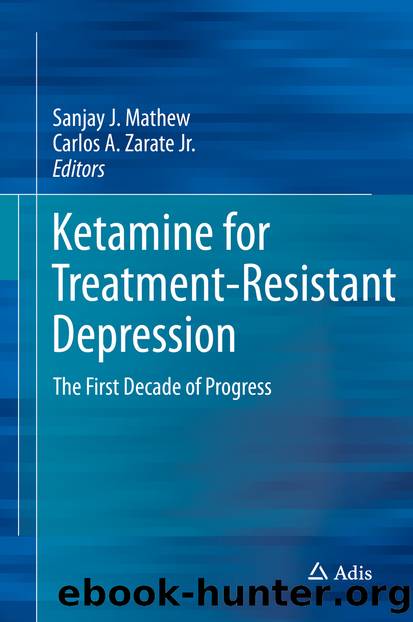Ketamine for Treatment-Resistant Depression by Sanjay J. Mathew & Carlos A. Zarate Jr

Author:Sanjay J. Mathew & Carlos A. Zarate, Jr.
Language: eng
Format: epub
Publisher: Springer International Publishing, Cham
6.2.2 Ketamine and Rodent Measures of Behavioral Despair
Reflecting proposed abnormalities in positive affective regulation, the forced swim test (FST) is perhaps the most well-validated assay of behavioral despair. When placed in cylinders containing water, rodents become rapidly immobile, floating passively or making only limited movements in order to remain afloat. The measure of immobility is correlated with behavioral despair. Time spent immobile has been reduced by short-term administration of antidepressants from a variety of classes including tricyclic antidepressants (TCAs), selective-serotonin reuptake inhibitors (SSRIs), and monoamine oxidase inhibitors (MAOIs) (Cryan et al. 2005). Numerous studies have shown that a single administration of a sub-anesthetic dose of ketamine produces acute reductions of immobility in the FST shortly after injection. However, as discussed below, the interpretation of studies examining more immediate effects of ketamine are confounded by other nonspecific actions of the drug such as its effects on locomotor behavior. Perhaps more importantly, in the FST and nearly every other behavioral assessment in rodents, there are conflicting findings that fail to detect acute effects of ketamine in mice (Bechtholt-Gompf et al. 2011) and in rats (Popik et al. 2008).
A particularly striking aspect of ketamine’s behavioral pharmacology profile, distinct from conventional antidepressants, is the protracted behavioral effects that can persist for days or even weeks after a single drug administration. The majority of studies indicate that the FST remains sensitive to the prolonged effects of ketamine for at least one week post a single injection (Ma et al. 2013; Yilmaz et al. 2002; Garcia et al. 2008; Maeng et al. 2008). This suggests that a single dose of ketamine may induce more sustained effects in the neural circuitry of despair than a single administration of a monoaminergic drug. Interestingly, these differences in the duration of drug effects challenge an earlier theory that classic antidepressants worked by modifying NMDA receptor expression and function (Paul et al. 1994).
The ability of other NMDA receptor antagonists to produce longer-lasting effects in the FST is less well established. In a direct comparison of the effects of memantine and ketamine on the FST, memantine showed no proximal behavioral effects in the hours after administration or at seven days postinjection (Gideons et al. 2014). Other studies showed that the NMDA receptor antagonist MK-801 failed to show the prolonged effects on the FST that were seen with ketamine, despite showing similar acute effects (within hours) on the FST (Autry et al. 2011; Zanos et al. 2016). However, others have shown that NMDA receptor antagonists such as RO 25-6981 and CPP do have enduring antidepressant effects lasting at least 24 hours in the FST (Li et al. 2011; Chowdhury et al. 2016; Autry et al. 2011).
The tail-suspension test (TST) is thought to be a less aversive assay of behavioral despair than the FST. Mice are suspended by their tails without the possibility of escape or support from nearby surfaces. During the test, usually lasting six minutes, escape-oriented behaviors are quantified; more escape-related activity is correlated with less behavioral despair. The TST has well-established
Download
This site does not store any files on its server. We only index and link to content provided by other sites. Please contact the content providers to delete copyright contents if any and email us, we'll remove relevant links or contents immediately.
| Grief & Bereavement | Hospice Care |
| Pet Loss | Suicide |
They Both Die at the End by Adam Silvera(8609)
Thirteen Reasons Why by Jay Asher(7786)
The Space Between by Michelle L. Teichman(6086)
Suicide Notes by Michael Thomas Ford(4271)
Tuesdays with Morrie by Mitch Albom(3832)
Suicide: A Study in Sociology by Emile Durkheim(2609)
The Checklist Manifesto by Atul Gawande(2202)
Tuesdays With Morrie by Mitch Albom(2170)
Robin by Dave Itzkoff(2005)
In the Woods by Tana French(1996)
Bossypants by Tina Fey(1986)
No Ashes in the Fire by Darnell L Moore(1980)
Reservoir 13 by Jon McGregor(1852)
End of Days by Sylvia Browne(1822)
Olive Kitteridge by Elizabeth Strout(1789)
Bus on Jaffa Road by Mike Kelly(1782)
All Things New by John Eldredge(1780)
Scar Tissue by Anthony Kiedis(1767)
No Time to Say Goodbye(1758)
